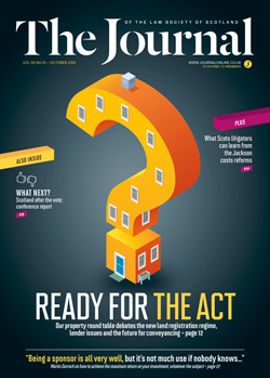Empowering communities

This article summarises some of the key provisions of the Community Empowerment (Scotland) Bill, introduced in the Scottish Parliament on 11 June 2014.
The bill is of potentially far reaching effect and makes a number of important reforms to community planning, community right to buy land, the role of participants in community planning, and public service delivery.
Of most interest to the profession is likely to be the extension of the community right to buy to urban land, and the new quasi-compulsory purchase powers that will be given for communities to acquire abandoned or neglected land. The bill is in seven parts, but this article focuses only on these two rights, which are most likely to be relevant to the profession.
Community right to buy
This allows the community to register an interest in land, with the opportunity to buy when it comes up for sale. The right can only be activated where the registered land is to be sold, or where the provisions of the Land Reform (Scotland) Act 2003 are breached.
The bill contains a number of significant amendments and additions to the 2003 Act. At present, only community bodies representing a rural area (i.e. with a population of less than 10,000) may exercise the right to buy. Section 27 of the bill extends the right to urban land, by amending the definition of “registrable land” and the power of the Scottish ministers to define “excluded land”. The net effect is to extend the community right to buy across Scotland (urban and rural).
“Registrable land” includes mineral rights (not oil, gas, coal, gold or silver), and salmon fishings.
The definition of the “community” who can exercise the right to buy has also been altered significantly. Under s 34 of the 2003 Act, the only legal entity that can register a community interest is a company limited by guarantee. Section 28 of the bill extends this to (1) a Scottish charitable incorporated organisation (SCIO), the new legal form for registered Scottish charities (subject to certain requirements such as no fewer than 20 members), and (2) any other body the Scottish ministers specify in regulations.
Sections 29-47 of the bill make a number of changes to the detailed procedures and requirements of the community right to buy. Under s 51(2)(a) of the 2003 Act, at least half the members of the community must have voted, or if not the proportion who voted must be sufficient to justify the purchase. Under s 36 of the bill the requirement is met if the proportion of the members who voted is sufficient to justify that the community buy the land.
Comment: There may be marked differences between urban and rural land both in terms of physical features and the likelihood of development. Urban land may be more likely to be subject to development proposals (e.g. allocated in a development plan for development and/or subject to an extant planning permission). While the Scottish ministers may in those circumstances conclude that the registration is not in the public interest, the uncertainty of registration could have an adverse impact on intended development proposals.
Abandoned or neglected land
This is an entirely new power. Section 48 of the bill provides for a community right to buy in certain circumstances without a willing seller. This is a similar process to compulsory acquisition, but is achieved through a different procedure. The proposals are based on the absolute right to buy under part 3 of the 2003 Act for crofting communities.
Following approval of an application by Scottish ministers, the owner will be required to transfer the land to the community for market value.
Abandoned or neglected land is not defined. “Land” is stated to include bridges and other structures built on or over land, and inland waters, canals and the foreshore, and is eligible if in the opinion of Scottish ministers it is wholly or mainly abandoned or neglected. In making that determination, minsters must have regard to prescribed matters.
“Eligible land” does not include land on which there is an individual’s home; croft land; certain land owned by the Crown; and land excluded by Scottish minsters in regulations.
Scottish ministers are only entitled to consent to the application if it is in the public interest and compatible with furthering the aims of sustainable development.
Comment: As with the extension of the part 4 right, there is uncertainty as to the application of this right, particularly where land might appear to be abandoned or neglected but is in fact subject to development proposals that may be frustrated by matters outwith the control of the owner.
In this issue
- Respect revived
- Adoption: when should contact continue?
- Family values
- Designs on IP law
- Section 29 claims, time bar and service
- Sharing the rewards
- Reading for pleasure
- Opinion: Lauren Wood
- Book reviews
- Profile
- President's column
- Making the big changeover
- People on the move
- Another leap forward
- LBTT: aligning payment and registration
- The (legal) people have spoken
- Powers of attorney: another angle
- Greatness begins with a pin badge
- Jackson: has it delivered?
- The test for causing alarm
- When do licensed premises "cease to be used"?
- Empowering communities
- Has clawback lost its tax bite?
- Scottish Solicitors Discipline Tribunal
- Property Law Committee Update
- Call it a comeback
- Refereeing the referendum
- Law reform roundup
- From the Brussels office
- What's next for SYLA?
- Mediation first
- When life begins at 60
- With growth there is risk? (2)
- Ask Ash
- Sustainable future: new ideas for the training contract
- Mentoring - why?
- Lender Exchange: what's it about?
- A bar removed






